Switzerland – The 6-Day Whirlwind Tour
Lausanne
I arrived at Lausanne around 19.30 on Wednesday night and found my hostel pretty easily (which is good since it was dark by that time). I have been impressed with all of the hostels that I have stayed in while traveling and the ones in Switzerland were no exception. Unfortunately, I had started catching a cold the day before I left for Switzerland, so my next stop was at the Pharmacie to get some cold medicine. After that, I got some dinner and went back to the hostel to settle in for the night.
On Thursday, 06.10.2005, I got up and took a train to the Chateau Chillon. It is a castle located on Lake Geneva, and it is also one of the most well-known castles in Switzerland. As an added bonus, this is one of the places that I visited during my last trip to Europe (8 years ago) and I wanted to come back and see it again. I enjoyed touring the Chateau, which is known as the place that inspired Lord Byron’s poem, “The Prisoner of Chillon.”
 After returning from the Chateau, I explored the Old Town of Lausanne and visited the Cathedral, which is the biggest church in Switzerland. I climbed the tower of the Cathedral and when I stepped out onto the balcony, I had an amazing view of the city. The sky was bright blue and so clear that I could see the mountains on the other side of Lake Geneva.
After returning from the Chateau, I explored the Old Town of Lausanne and visited the Cathedral, which is the biggest church in Switzerland. I climbed the tower of the Cathedral and when I stepped out onto the balcony, I had an amazing view of the city. The sky was bright blue and so clear that I could see the mountains on the other side of Lake Geneva.
 I finished exploring the Old Town and ate dinner at a self-service cafeteria called Manora, and then I decided to head down to the Ouchy district. The Ouchy district is on the waterfront of Lake Geneva, and it includes a large marina and a boardwalk. I walked along the waterfront and watched all of the skateboarders and families enjoying the beautiful evening. Lausanne is known as the “Olympic Capital” of the world because the International Olympic Committee is headquartered there, and they have a large Olympic Museum (Musee Olympique) located in the Ouchy district. When I arrived at the museum, it was already closed for the night since it was after 18.00. This did not bother me since my main reason for coming was to walk around the gardens and see the Olympic flame. However, when I arrived at the flame, all I could see was the natural gas coming out of the fixture – apparently, they only turn the flame on at noon every day. So, I did what any normal tourist would do – took a picture of the flame fixture (minus the flame) to prove that I was there, and headed back down the waterfront to enjoy the evening.
I finished exploring the Old Town and ate dinner at a self-service cafeteria called Manora, and then I decided to head down to the Ouchy district. The Ouchy district is on the waterfront of Lake Geneva, and it includes a large marina and a boardwalk. I walked along the waterfront and watched all of the skateboarders and families enjoying the beautiful evening. Lausanne is known as the “Olympic Capital” of the world because the International Olympic Committee is headquartered there, and they have a large Olympic Museum (Musee Olympique) located in the Ouchy district. When I arrived at the museum, it was already closed for the night since it was after 18.00. This did not bother me since my main reason for coming was to walk around the gardens and see the Olympic flame. However, when I arrived at the flame, all I could see was the natural gas coming out of the fixture – apparently, they only turn the flame on at noon every day. So, I did what any normal tourist would do – took a picture of the flame fixture (minus the flame) to prove that I was there, and headed back down the waterfront to enjoy the evening.

Interlaken and the Schilthorn
I left Lausanne on Friday morning (07.10.2005) and headed for Interlaken, a small town at the base of the Swiss Alps. My objective was to go to the top of the Schilthorn, which is the mountain where they filmed part of the James Bond movie “On Her Majesty’s Secret Service.” The Piz Gloria, a revolving restaurant, and a viewing platform are located on the top of the Schilthorn. If you would like to learn more info on how the James Bond movie and the Schilthorn are linked, go to http://www.schilthorn.ch/(there is a button on top of the menu to translate the site into English).
 I had to take two trains, a funicular, and two gondolas to get to the top of the Schilthorn (it is 10,000 feet high). I could feel my ears popping as we kept going up towards the mountain. When I got to the top, it was COLD! It was about 23ºF, as opposed to the 50ºF weather at the bottom of the mountain. I went out onto the viewing platform, and it was snowing. That means that I saw snow twice within one week, and it was only the 7th of October. (I can tell that this is going to be a rough winter for me.) I do have to say that the Swiss Alps were phenomenal, so I did not mind the cold weather too much. It is so mesmerizing to see all of this beauty surrounding me.
I had to take two trains, a funicular, and two gondolas to get to the top of the Schilthorn (it is 10,000 feet high). I could feel my ears popping as we kept going up towards the mountain. When I got to the top, it was COLD! It was about 23ºF, as opposed to the 50ºF weather at the bottom of the mountain. I went out onto the viewing platform, and it was snowing. That means that I saw snow twice within one week, and it was only the 7th of October. (I can tell that this is going to be a rough winter for me.) I do have to say that the Swiss Alps were phenomenal, so I did not mind the cold weather too much. It is so mesmerizing to see all of this beauty surrounding me.
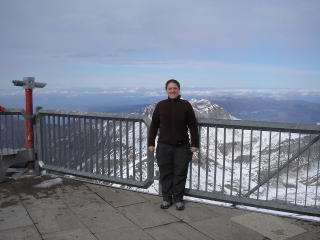 After my trip to the Schilthorn, I came back to Interlaken and checked into my hostel. I asked the desk clerk for a recommendation of a good restaurant for Swiss fondue that was not touristy – someplace where the locals would go to eat. So, she told me about the Restaurant Laterne. It is a quaint restaurant located on a side street in Interlaken, and it was exactly what I had asked for. I had a wonderful mixed green salad and traditional Laternen fondue, which is a cheese sauce with white wine and garlic that you dip chunks of bread into. It was the perfect ending to a wonderful day in the Swiss Alps.
After my trip to the Schilthorn, I came back to Interlaken and checked into my hostel. I asked the desk clerk for a recommendation of a good restaurant for Swiss fondue that was not touristy – someplace where the locals would go to eat. So, she told me about the Restaurant Laterne. It is a quaint restaurant located on a side street in Interlaken, and it was exactly what I had asked for. I had a wonderful mixed green salad and traditional Laternen fondue, which is a cheese sauce with white wine and garlic that you dip chunks of bread into. It was the perfect ending to a wonderful day in the Swiss Alps.
 Lucerne
Lucerne
I took the 7.08 train to Lucerne on Saturday, 08.10.2005. I arrived in town that morning and dropped my luggage off at my hostel so that I could spend the day exploring. My first visit was to the Fortress Furigen. This museum is actually located between the towns of Stansstad and Furigen, so I took a 15 minute train ride to get there. The Fortress Furigen is an actual fortress that the Swiss government built in 1941. It was built as part of a plan to protect Switzerland in case of a Nazi invasion. Many fortresses like this one were built in the Alps. If an invasion occurred, the Swiss government would go to a secret bunker in the center of the Alps while the troops left their border posts to gather around the fortresses in the Alps. But, after the end of the cold war, the government decided to open it up to the public as a museum. As an aside, the Swiss roadway system was designed so that it could be destroyed – if an invasion occurred all of the roads leading into the country could be blown up, making the entire country into a mountain fortress.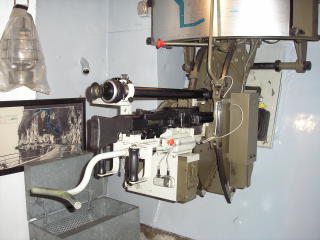 The inside of the fortress was an interesting place – lots of dark, damp passages and rooms cut out into the mountain. It was somewhat unnerving when I first arrived, because I never would have found the place if I had not seen the wooden ticket stand built onto the side of the mountain. I walked into the museum and the first thing I saw was a machine gun aimed at the place where I had been standing outside. Seeing that machine gun aimed in that direction sent a little chill up my spine. Overall, the exhibits in the rooms were well done, but I must admit that the museum gave me a strange feeling when I left. I am used to seeing military museums that have well-lit rooms with exhibits displayed in glass cases – a very clinical and sterile environment. However, this museum was completely different. It was such a cold, calculating place, and it made me think about the “art” of warfare in a totally different light. It also made me wonder what other fortresses I might be walking past without even knowing it.
The inside of the fortress was an interesting place – lots of dark, damp passages and rooms cut out into the mountain. It was somewhat unnerving when I first arrived, because I never would have found the place if I had not seen the wooden ticket stand built onto the side of the mountain. I walked into the museum and the first thing I saw was a machine gun aimed at the place where I had been standing outside. Seeing that machine gun aimed in that direction sent a little chill up my spine. Overall, the exhibits in the rooms were well done, but I must admit that the museum gave me a strange feeling when I left. I am used to seeing military museums that have well-lit rooms with exhibits displayed in glass cases – a very clinical and sterile environment. However, this museum was completely different. It was such a cold, calculating place, and it made me think about the “art” of warfare in a totally different light. It also made me wonder what other fortresses I might be walking past without even knowing it.
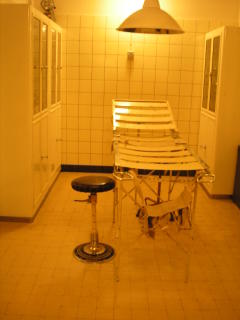 After the Fortress Furigen, I headed back to Lucerne and went to the Swiss Transport Museum. This is a museum that houses so many different exhibits that it is overwhelming – and they are all about transportation! I enjoyed seeing the different exhibits on cars, planes, trains, and even an exhibit on the building of the Gotthard Tunnel (which is the main road through the Alps connecting upper Switzerland with Italy). Plus, since the museum is on the waterfront of Lake Lucerne, I was also able to enjoy some wonderful scenery as I walked to and from it.
After the Fortress Furigen, I headed back to Lucerne and went to the Swiss Transport Museum. This is a museum that houses so many different exhibits that it is overwhelming – and they are all about transportation! I enjoyed seeing the different exhibits on cars, planes, trains, and even an exhibit on the building of the Gotthard Tunnel (which is the main road through the Alps connecting upper Switzerland with Italy). Plus, since the museum is on the waterfront of Lake Lucerne, I was also able to enjoy some wonderful scenery as I walked to and from it.
 The next stop on my itinerary was the “Crying Lion.” This is a statue that represents the Swiss mercenaries who died while fighting in the French Revolution. The inscription above the lion says ‘Helvetiorum fidei ac virtuti,’ which means ‘To the loyalty and bravery of the Swiss.’
The next stop on my itinerary was the “Crying Lion.” This is a statue that represents the Swiss mercenaries who died while fighting in the French Revolution. The inscription above the lion says ‘Helvetiorum fidei ac virtuti,’ which means ‘To the loyalty and bravery of the Swiss.’
 On Sunday morning, 09.10.2005, I decided to head to Bern for a night (even though it was not originally in my plans), so I walked around Lucerne a little bit more before I caught my train. One of the most beautiful sights that I saw was the old Chapel Bridge and Water Tower.
On Sunday morning, 09.10.2005, I decided to head to Bern for a night (even though it was not originally in my plans), so I walked around Lucerne a little bit more before I caught my train. One of the most beautiful sights that I saw was the old Chapel Bridge and Water Tower.
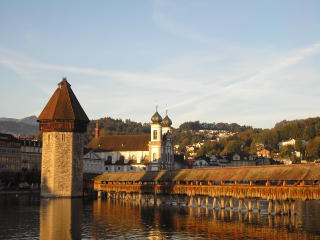
The town of Bern is the capital of Switzerland, and when I arrived there I immediately started exploring the area. The tourist information center had a good city map with a walking tour, so I started out with that first. As I walked along looking at the different sights, I noticed that Bern has a lot of fountains. You see them in the middle of the streets, in the middle of the squares on street corners, etc. I bought a guide book, and found out that the city has over 100 fountains! Here are two of my favorites:



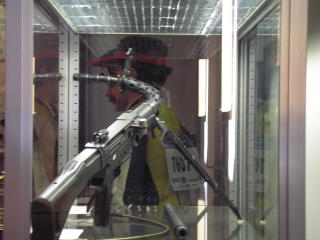
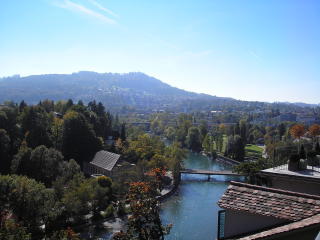
I will have pictures posted in my photos page in the next couple of weeks. Click on Andria’s Travel Photos and look for the ‘Switzerland’ folder.
~Andria

0 Comments:
Post a Comment
<< Home